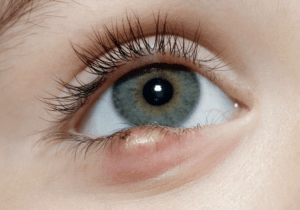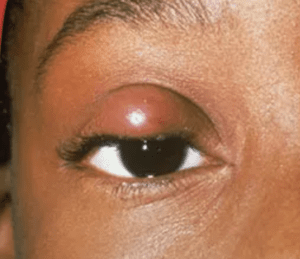Stye vs. Chalazion


June 22, 2022
How do I know if it’s a Stye or a Chalazion?
The answer is: your eye doctor will be able to tell you after examining your eyes. They are both basically pimples that arise from oil glands in your eyelids and create a painful red lump.
A Stye is generally:
- On the skin at where your eyelash attaches to the skin
- On the edge of your eyelid
- Generally more painful/tender
- Is an infection
A Chalazion is generally:
- A lump at farther away from the edge of your eyelid (although can extend to the edge)
- Mostly non-tender
- Is caused by a blocked oil gland
- Similar to a pimple elsewhere on your skin
- May become a non-tender nodule that can go away on its own
- Can be removed surgically also
Millions of people have these every year and it’s always a cause for concern. There are several similar and often interchangeable terms that are slightly different. (although the differences are academic, not really important for the most part). The term hordeolum, stye, and chalazion all have slightly different meanings.
Chalazion vs. Stye
What is a Stye?
A stye is often quite painful. It usually arises at the edge of your eyelid, and believed to be caused by an infected eyelash root. It usually swells and can affect the entire eyelid. The keyword here is “infection“. The infectious agent is usually staphylococcus which is one of a species of bacteria that is normally present on our skin and therefore also our eyelids. It is a combination of the lack of flow in the oil glands (gland of Zeis and Moll) of our eyelids along with bacteria which get trapped in the oil gland. Less commonly pseudomonas aeruginosa bacteria can be the cause of this infection. 2/3 of styes will drain on their own without any medical intervention. Warm compresses, gentle massage and time will allow the oil that is blocked in the duct of your eyelid to drain out. It may also be helpful and preventative to put antibiotic ointment such as polymyxin or erythromycin ointment on the edge of your lid to decrease the number of bacteria and prevent spread to other glands.
What is a Chalazion?
A chalazion on the other hand, usually arises painlessly to become a bump that develops a bit farther back from the edge on the eyelid as compared to a stye. It is caused by a clogged oil gland-the glands of Zeis or the glands of Moll. Rarely does it make the entire eyelid swell. It can evolve into a non-tender bump in your eyelid. If it is esthetically bothersome, it can be removed surgically. It also may be left alone if it doesn’t bother you. It may go away on its own over time. People who have several chalazia may have a condition such as blepharitis or meibomian gland dysfunction that predisposes them to develop chalazia. We each have about 25 Meibomian glands in our upper and lower lids. They secrete oil called sebum that helps our eyes stay lubricated and healthy. When they get inflamed or blocked is when a chalazion may develop.
“Styes and Chalazia are one of the most, if not THE most common eye affliction.”
Dr. Sharpe
What is the cause of a Chalazion?
Often, but not always a chalazion is the result of inflammation around the margins of your eyelids. The eyelids get inflamed and the ducts shut off, the oil gets thicker and inspissated which means that it gets plugged in the gland. Sometimes you’ll have a “white head,“ on the edge of the eyelid. This usually means that the duct is blocked and you may develop a chalazion. There’s also a condition called meibomian gland dysfunction where the edge of your eyelids gets red and you can see the blocked oil glands. There’s a condition called rosacea that’s also often associated with meibomian gland dysfunction. Rosacea is where there is redness and dilated blood vessels in the area of your forehead, cheeks, nose, and tip of your chin. This is a chronic condition but often responds to dietary changes, antibiotics such as doxycycline. You must consult your primary care doctor or dermatologist to help with this because it is chronic, inflammatory and causes unsightly skin problems if left untreated.
How do you get rid of a Chalazion?
A chalazion generally can be left alone. I have found that the conventional wisdom of warm compresses and massage doesn’t work very well for a chalazion. They are deep in the eyelid and rarely express themselves and go away. They either go away on their own (which is a process of macrophages – a type of cell that clears away any cellular waste and dead cells. With a chalazion they digest the oil and carry it away from the nodule. This process can take weeks to to months to go away). One thing that definitely does not help is antibiotic eye drops. Antibiotic drops are designed to kill bacteria on the inside of the eyelids, the surface of the eyes, but do not penetrate into a chalazion. A chalazion is not an infection anyway, it’s an accumulation of sebum or oil that gets blocked in an oil gland just as a pimple does in acne.
What is the surgical treatment for a Chalazion?
If a chalazion is aesthetically unpleasant, has persisted for more than a month and is nontender and/or causing the upper eyelid to droop it can be removed surgically. There are two basic surgical ways:
One technique is to inject the chalazion with Kenalog (triamcinolone – a steroid) a very small amount of potent steroid often works to diminish the chalazion. The other technique is to numb in the eye with lidocaine and use a special instrument to turn the lid inside out and make a tiny vertical incision and remove all of the sebum/oil. This sounds painful but it isn’t-the eyelid is numbed adequately so you will be comfortable throughout.
Can a Stye turn into a Chalazion?
Not generally. They are two different conditions and two different appearances, causes and treatments.
Difference between Stye and Chalazion:
The difference between a stye and a chalazion are significant in terms of the way they are treated, the risks, and the way it feels, but they can look similar.
A stye is an infection of a hair follicle; in this case it’s the eyelash follicle. It can cause your entire lid it swell, be quite tender, and can progress to a preseptal cellulitis or even orbital cellulitis. Preseptal cellulitis is an infection that affects the tissues toward the front of you eyelids and the skin and tissue around your eyes. Orbital cellulitis is an infection that extends into the deeper tissues around your eye, and is a medical emergency. So a stye, while seemingly just a nuisance, can progress to a dangerous condition.
A chalazion typically is a nuisance but not likely to progress to a dangerous condition. It is a non-infectious enlargement of the glands that secrete oil onto the surface of your eyes to keep them lubricated.
Chalazion versus Stye
If I had to have one or the other, I’d choose a chalazion, as it’s not an infection and not as dangerous. (But you don’t have to have them!)
Stye versus Chalazia?
Chalazion is the singular form, and chalazia is the plural (more than one) for of the word
Chalazion vs. Hordeolum or Hordeolum vs. Chalazion?
Toe-MAY-toe, Toe-MAH-toe. A horedeolum is synonymous with (means the same thing as) a stye, so all the above about a stye is the same for hordeolum.
“Internal stye” just means that the infected oil gland is more on the inside of the eyelid, which often happens. There are glands through the thickness of our eyelids, so some appear more internal and some appear more external.
What does a stye look like:
A stye is a red pimple right at the edge of your eyelid. It tends to be painful but usually does not cause your entire eyelid to swell up through.
Stye or Hordeolum

Chalazion


Dr. Matthew R. Sharpe
